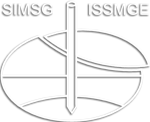Evaluation on hydraulic conductivity of saturated bentonites containing different exchangeable cation composition
Evaluation on hydraulic conductivity of saturated bentonites containing different exchangeable cation composition
Barrier materials with low permeability are required for disposal facilities of radioactive wastes, therefore, bentonites are planned to be used. The required permeability varies depending on the radioactivity of wastes, so various bentonites are being considered. In Japan, for high-level radioactive waste (HLW) disposal, Na-bentonite which has low permeability, will be used. While for low-level radioactive waste (LLW) disposal, Ca-bentonite which has relative higher permeability than Na-bentonite in same dry density, can be used. Because HLW disposal project will take several decades to complete, it is necessary to consider a wide range of optional bentonites. In this study, a Mg-Ca bentonite (MG), in which Mg2+ and Ca2+ between montmorillonite layers are dominant, a Na-bentonite (K_V1) and a Ca-bentonite (KB) was studied and compared in terms of their hydraulic conductivity k. A newly developed test system with specimen thickness of 2 mm was used for obtaining k, by which results can be obtained in a few days, much shorter than conventional test systems. The results showed that k of all bentonites tended to decrease as dry density increased. The effective montmorillonite density ρem, calculated by dividing the dry mass of montmorillonite by the volume of montmorillonite and pore, was used as a parameter to compare among tested bentonites. The k of MG and KB was 2 to 10 times higher than that of K_V1 in terms of ρem in the range of 0.8~1.2 Mg/m3. The k of KB and MG were found to be almost the same under the same ρem.
Daichi Ito; Hailong Wang; Hideo Komine
9th International Congress on Environmental Geotechnics (ICEG2023)
Advances in Testing and Material Characterization
Geoenvironmental Engineering
https://doi.org/10.53243/ICEG2023-308
